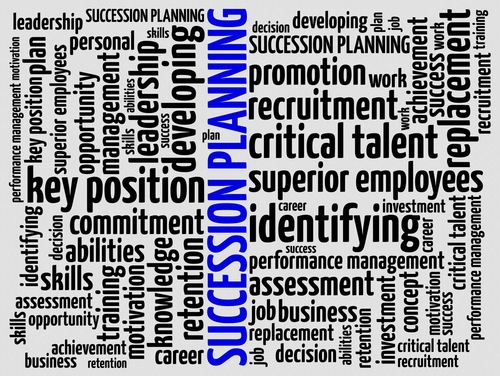Succession planning—it’s not a new phenomenon, says consultant Mary Anne Kennedy, but it’s critically important and often done poorly. What will you do if a key person leaves, and there is no replacement?
 |
By the way, that key person doesn’t have to be a top executive. Kennedy had one client that lost its payroll person, and no one else in the organization knew how to process payroll. A disaster.
Kennedy, who is the principal consultant of MAKHR Consulting, LLC, and author of the career coaching book “Finding The Right Job; A Step By Step Approach,” offered her succession planning tips at a recent BLR-sponsored webinar.
What is Succession Planning?
Succession planning is the process where organizations recruit and develop key talent to fill roles within the company beyond the position they are originally hired to perform, says Kennedy.
Replacement Planning and Succession Planning
Many organizations do replacement planning and think they have done succession planning, says Kennedy. Replacement planning simply identifies a person who could take over a position if the position becomes vacant. Succession planning goes beyond that to identify employees with potential and to develop their knowledge, skills, and abilities to prepare them for advancement or promotion into more challenging roles.
Research indicates that replacement planning is not overly effective, says Kennedy.
Why is succession planning now on every company’s radar? Most companies, says Kennedy, face Baby Boomers retiring, and many of those are employees with 30 years of accumulated knowledge. Are you prepared to handle this?
It’s the brave new world of HR. Start your strategic thinking with BLR’s new practical guide: HR Playbook: HR’s Game Plan for the Future.
Why Have a Succession Planning Process?
A well-designed program:
- Increases availability of qualified employees.
- Improves retention of top talent. When top/key talent feels challenged and rewarded, the desire to seek opportunities outside the current employer starts to diminish.
The Fundamentals of Successful Succession Planning:
Kennedy offers the following fundamentals of meaningful and effective programs:
- Leadership must recognize that developing leadership talent is a long-term investment.
- Employees have to be committed to their own development.
- When deciding on development opportunities, several inputs are best. Kennedy recommends “calibration meetings” where several leaders discuss potential candidates for development. Try to avoid “gut” decisions. You want to have measurable quantitative information, not just gut feelings. This is especially important to meet legal obligations, says Kennedy.
HR 2015? Time to start planning with BLR’s new HR Playbook. Find out more or order here—HR Playbook: HR’s Game Plan for the Future.
- Development must start with expectations—behaviors and competencies. You can’t let people get to senior position to find out that they are not really good leaders, says Kennedy.
- Development is not promotion, it’s getting a breadth of knowledge, which is often gained by moving across the organization, not always up.
- Don’t hire new people for a position, always be thinking, is there somewhere else this person can go, so he or she doesn’t get bored.
- The succession process is not an event. It involves ongoing dialogue, at least monthly or quarterly.
- The process must be simple and realistic for all to willingly engage. If it is cumbersome, people just won’t do it.
Steps along the way include:
- Identify key positions or roles for succession planning—those jobs that require skills and abilities possessed by only a limited number of people. You need to know the critical positions where only one person knows how to do a function. In large companies, these positions may be unnoticed.
- Define the competences and motivational profiles required for these roles, the value systems, and the behaviors.
- Identify those with the potential to assume greater responsibility. Vet these people in some sort of forum across the organization.
- Engage the leadership in supporting the development of high potential employees.
- Develop a database to showcase “ready now” candidates.
- Develop a job matrix for key positions in order to clearly identify feeder positions. (See templates in tomorrow’s Advisor.)
Some additional principles of developing a successful program include:
- Don’t wait until key talent decides to resign.
- Utilize the policies, procedures and practices that are already established in your organization. Midyear review? Performance management system? Review of objectives during the year? Are people getting the exposure and experiences they need?
- Behaviors weigh equally with results in the program. You can’t just put a high producer in a high potential program; you have to vet behaviors as well.
- Communicate clearly, timely, and effectively. As you are developing the program, be sure that all employees find out about it.
- Seek feedback about the program from leaders and employees.
In tomorrow’s Advisor, templates that Kennedy recommends for succession planning, plus an introduction to the new guide, HR Playbook: HR’s Game Plan for the Future.

Long ago I worked at a bar association whose executive director died without warning. He had no deputy or clear successor and the organization had done zero succession plan. It was a disastrous year as the remotely located board members scrambled to find a replacement, hiring a very pricey recruiting firm while the position was filled with a long-time employee no one wanted in the position permanently.
Yes, absolutely re: your points about replacement planning not being the same as succession planning. It’s not enough to have a replacement if that replacement hasn’t been prepared and developed for their new role… and that preparation isn’t something that can occur over the course of a slap dash onboarding session if something unexpected happens, as in Barb’s comment. Here are a few more thoughts on that: http://insala.com/Articles/Mentoring/mentoring-solutions-for-succession-planning-problems.asp?utm_source=comment&utm_medium=blog&utm_campaign=comment